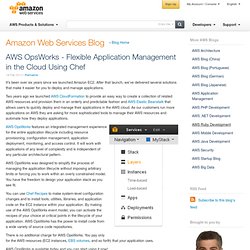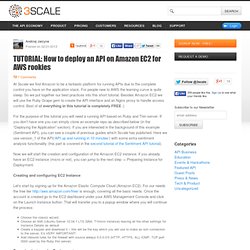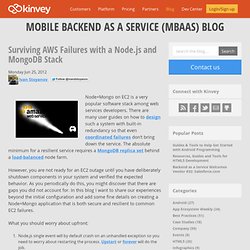

AWS OpsWorks - Flexible Application Management in the Cloud Using Chef. It’s been over six years since we launched Amazon EC2.

After that launch, we’ve delivered several solutions that make it easier for you to deploy and manage applications. Two years ago we launched AWS CloudFormation to provide an easy way to create a collection of related AWS resources and provision them in an orderly and predictable fashion and AWS Elastic Beanstalk that allows users to quickly deploy and manage their applications in the AWS cloud. As our customers run more applications on AWS they are asking for more sophisticated tools to manage their AWS resources and automate how they deploy applications.
AWS OpsWorks features an integrated management experience for the entire application lifecycle including resource provisioning, configuration management, application deployment, monitoring, and access control. It will work with applications of any level of complexity and is independent of any particular architectural pattern. There is no additional charge for AWS OpsWorks. -- Jeff;
Quickstart tutorial on how to deploy an API on Amazon EC2 for Amazon Web Services (AWS) rookies - 3scale API Management Platform & Infrastructure. At 3scale we find Amazon to be a fantastic platform for running APIs due to the complete control you have on the application stack.

For people new to AWS the learning curve is quite steep. So we put together our best practices into this short tutorial. Besides Amazon EC2 we will use the Ruby Grape gem to create the API interface and an Nginx proxy to handle access control. Best of all everything in this tutorial is completely FREE :) For the purpose of this tutorial you will need a running API based on Ruby and Thin server. Now we will start the creation and configuration of the Amazon EC2 instance. Creating and configuring EC2 Instance Let’s start by signing up for the Amazon Elastic Compute Cloud (Amazon EC2).
Preparing Instance for Deployment Now, as we have the instance created and running, we can directly connect there from our console (Windows users from PuTTY). Follow the steps and change the username to ubuntu (instead of root) in the given example. Deploying the Application. Broken PMTUD on Amazon EC2. While at Amazon re:invent I had the opportunity to complain to some Amazonians again about an EC2 bug which has been annoying me for a long time: The default firewall rulset is broken.

I discovered this three years ago while debugging odd problems experienced by a Tarsnap user — sending a small amount of traffic worked fine, but as soon as large amounts of traffic started moving around, the TCP connection got stuck — and I've been complaining from time to time ever since; but somehow face-to-face communications tend to produce better results than mere emails. As most standards-aware network administrators know, blocking ICMP is evil. Sure, there are certain ICMP packets which should be blocked; but to quote RFC 2979: and yet this is exactly what the default EC2 firewall does: It blocks all incoming ICMP packets, including ICMP "fragmentation needed" packets.
The fix for EC2 users is easy, and I recommend applying it universally: Run. Surviving AWS Failures with a Node.js and MongoDB Stack. Node+Mongo on EC2 is a very popular software stack among web services developers.

There are many user guides on how to design such a system with built-in redundancy so that even coordinated failures don’t bring down the service. The absolute minimum for a resilient service requires a MongoDB replica set behind a load-balanced node farm. However, you are not ready for an EC2 outage until you have deliberately shutdown components in your system and verified the expected behavior. As you periodically do this, you might discover that there are gaps you did not account for.
In this blog I want to share our experiences beyond the initial configuration and add some fine details on creating a Node+Mongo application that is both secure and resilient to common EC2 failures. What you should worry about upfront: Node.js single event will by default crash on an unhandled exception so you need to worry about restarting the process. Are you good to go for the next AZ outage? Not quite. Connecting to Instances. Amazon Elastic Compute Cloud User Guide (API Version 2014-02-01) Connect to Your Instance This section describes how to connect to instances that you launched and how to transfer files between your local computer and your instance.

After you connect to your instance, you can try one of our tutorials, such as Tutorial: Installing a LAMP Web Server or Tutorial: Hosting a WordPress Blog with Amazon EC2. <div class="yui-b" style="padding: 20px; padding-top: 0;"><div class="yui-ge"><div class="yui-u first"><div id="error_messages"><img src=" style="float: left;" alt="Warning"><div style="float:left; margin-left: 1em;"><strong>Javascript is disabled or is unavailable in your browser.